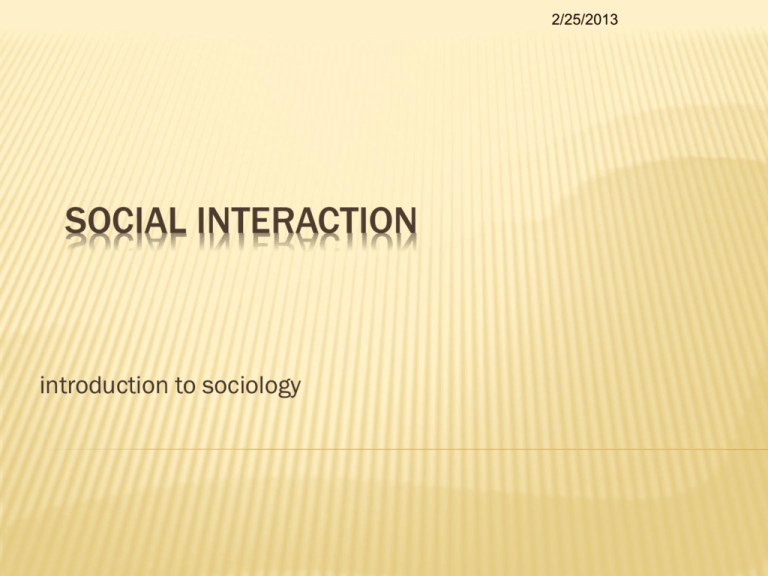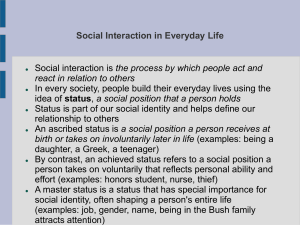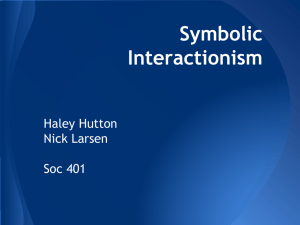social interaction
advertisement

2/25/2013 SOCIAL INTERACTION introduction to sociology SOCIAL INTERACTION – LECTURE OUTLINE Social structure, social position, and social roles Erving Goffman’s Dramaturgy Harold Garfinkel’s Ethnomethodology Conversation analysis Conformity SOCIAL INTERACTION – LECTURE OUTLINE Social structure, social position, and social roles Erving Goffman’s Dramaturgy Harold Garfinkel’s Ethnomethodology Conversation analysis Conformity SOCIAL STRUCTURE, SOCIAL POSITION, AND SOCIAL ROLES Social context In order to understand a conversation, we need to understand the social context. E.g., electronic communication such as email or text messaging can lead to miscommunication because of lack of context. E.g., Three’s Company SOCIAL STRUCTURE, SOCIAL POSITION, AND SOCIAL ROLES Social structure the underlying regularities or patterns in how people behave and their relationships with one another E.g., classroom, inner city Social position (social status) the particular slot or position that you occupy in any given social structure E.g., student, child, parent, employee, spouse Our social position in any particular group importantly shapes how we behave in that group. SOCIAL STRUCTURE, SOCIAL POSITION, AND SOCIAL ROLES Social role Socially defined expectations of a person in a given social position E.g., teacher’s social role—speak at a level students can understand, respond to students’ questions, give fair exams E.g., arrive to class on time, raise your hand before speaking, turn in assignments on time—these expectations are part of the social role of students. Social role significantly shapes, but does not fully determine how we will behave. SOCIAL INTERACTION – LECTURE OUTLINE Social structure, social position, and social roles Erving Goffman’s Dramaturgy Harold Garfinkel’s Ethnomethodology Conversation analysis Conformity ERVING GOFFMAN’S DRAMATURGY Focus on the “trivial” Impression management Dramaturgy ERVING GOFFMAN’S DRAMATURGY Focus on the “trivial” Impression management Dramaturgy FOCUS ON THE “TRIVIAL” Erving Goffman pioneering sociologist who developed microsociology and emphasized the importance of understanding the “seemingly trivial” FOCUS ON THE “TRIVIAL” civil inattention Civil inattention is defined as acknowledging the presence of others but avoiding interaction. rather unconscious signals to the other that one does not suspect the other’s behavior social life is allowed to proceed in an orderly fashion e.g., two people walking on a city sidewalk quickly glance at each other and then look away as they pass FOCUS ON THE “TRIVIAL” audience segregation People engage in audience segregation to reconcile their role in one part of life with their role in another part of their social world. E.g., being openly gay at home but being “straight” at work for fear of discrimination. E.g., while grocery shopping, you run into your sociology professor. This creates an awkward interaction since you are not used to seeing her outside of class and you are not sure how to behave. FOCUS ON THE “TRIVIAL” response cry purpose: to show others one’s continued competence in daily routines e.g., a student drops a spoon on the floor as she carries her dish to the kitchen. As the spoon clatters loudly on the tile floor she exclaims, “Ooooooh, sorry!” ERVING GOFFMAN’S DRAMATURGY Focus on the “trivial” Impression management Dramaturgy IMPRESSION MANAGEMENT People use impression management to compel others to react to them in ways they wish. E.g., a CEO wears a suit and tie to a board meeting and later in the day changes into jeans and a T-shirt to attend a football event with friends. E.g., wearing a new dress on a first date. IMPRESSION MANAGEMENT “There is no occasion of talk so trivial as not to require each participant to show serious concern with the way in which he handles himself and the others present." Goffman IMPRESSION MANAGEMENT We do impression management because we are sensitive about how others see us. humans tend to collaborate with others to make sure that interactions end without embarrassment E.g., Maria’s friend posted an unflattering picture of her from a Halloween party on Facebook. Maria was embarrassed and quickly took it down since she is friends with many coworkers on Facebook. DIFFERENCES IN CONCERN FOR THE OTHER’S FACE differences in concern for the other’s face more likely to be concerned relationship is not close you like the person less power ERVING GOFFMAN’S DRAMATURGY Focus on the “trivial” Impression management Dramaturgy DRAMATURGY Analogy of theater Style Cynical and sincere Emotion labor (Hochschild) DRAMATURGY Analogy of theater Style Cynical and sincere Emotion labor (Hochschild) DRAMATURGY Uses the analogy of theater According to Erving Goffman, social interaction is like performing a play in a theater. We are all actors (see first date slide) Front region, back region E.g., the calm professor in your sociology class may behave quite forcefully in a department meeting: that is, she could act in ways she did not want her students to witness. THE FIRST DATE, LIKE THEATER characters back stage front stage costumes props scripts DRAMATURGY Analogy of theater Style Cynical and sincere Emotion labor (Hochschild) THE IMPORTANCE OF STYLE Our style (how well we can act) importantly determines whether our performance will be accepted or not. (see next slide) THE RELATION BETWEEN CONTENT AND SYMPTOMATIC ACTION (STYLE) Content Positive Symptomatic Audience reaction action Positive Performance accepted Positive Negative Negative Positive Negative Negative Performance damaged Performance accepted if content cannot be checked Performance rejected Dramaturgy – the importance of style DRAMATURGY Analogy of theater Style Cynical and sincere Emotion labor (Hochschild) CYNICAL AND SINCERE Cynical Do not believe our own performance almost all of us are cynical sometimes Sincere Believe that we are who we are pretending to be DRAMATURGY Analogy of theater Style Cynical and sincere Emotion labor (Hochschild) THE MANAGED HEART, ARLIE HOCHSCHILD According the Arlie Hochschild, flight attendants use several strategies to manipulate their emotions since it is part of their job requirement to have particular feelings. surface acting deep acting deep acting with body self prompting method acting SURFACE ACTING If I pretend I’m feeling really up, sometimes I actually get into it. The passenger responds to me as though I were friendly, and then more of me responds back. Dramaturgy. Emotion labor DEEP ACTING WITH BODY Sometimes I purposely take some deep breaths. I try to relax my neck muscles. Dramaturgy. Emotion labor DEEP ACTING, SELF-PROMPTING I may just talk to myself: “Watch it. Don’t let him get to you. Don’t let him get to you. Don’t let him get to you.” And I’ll talk to my partner and she’ll say the same thing to me. After a while, the anger goes away. Dramaturgy. Emotion labor DEEP ACTING, METHOD ACTING I try to remember that if he’s drinking too much, he’s probably scared of flying. I think to myself, “He’s like a little child.” Really, that’s what he is. And when I see him that way, I don’t get mad that he’s yelling at me. He’s like a child yelling at me then. Dramaturgy. Emotion labor DRAMATURGY Analogy of theater Style Cynical and sincere Emotion labor (Hochschild) ERVING GOFFMAN’S DRAMATURGY Focus on the “trivial” Impression management Dramaturgy SOCIAL INTERACTION – LECTURE OUTLINE Social structure, social position, and social roles Erving Goffman’s Dramaturgy Harold Garfinkel’s Ethnomethodology Conversation analysis Conformity HAROLD GARFINKEL’S ETHNOMETHODOLOGY Harold Garfinkel founded the field of ethnomethodology the study of micro interaction how people sustain meaningful interactions with each other. the study of ethnomethods folk or lay methods people use to make sense of what others say and do every person uses in day-to-day life HAROLD GARFINKEL’S ETHNOMETHODOLOGY we live in a world that we create E.g., we assume that the world makes sense and we try to make sense of it E.g., pets counseling we are not aware of the taken-for-granted rules that we follow E.g., breaching experiments (see next slide) BREACHING EXPERIMENT Harold Garfinkel conducted experiments in which students were encouraged to pursue the precise meaning of general or casual comments. The intent was to uncover the background expectancies. People use background expectancies to structure and organize everyday conversation. Communicating through plain, everyday language requires an array of complex, shared background understandings. BREACHING EXPERIMENT According to Garfinkel, people tend to get upset when minor conventions of talk are not followed. (see next slide) His explanation for this reaction is that it is disturbing when people disrupt the stability and undermine the cultural assumptions about what is said and why. BREACHING EXPERIMENT S: How are you? E: How am I in regard to what? My health, my finance, my school work, my peace of mind, my ... S: (red in face and suddenly out of control) Look! I was just trying to be polite. Frankly I don’t give a damn how you are. SOCIAL INTERACTION – LECTURE OUTLINE Social structure, social position, and social roles Erving Goffman’s Dramaturgy Harold Garfinkel’s Ethnomethodology Conversation analysis Conformity CONVERSATION ANALYSIS The technique used to examine the organized principles of talk is called conversation analysis. interactional vandalism Interactional vandalism is defined as a subordinate person breaking the tacit rules of interaction E.g., a street vendor tries to sell products to people by walking next to them and putting the products in people’s line of vision. As he does so, people ignore him and avert their eyes. Interactional vandalism, such as when men on the street call out to and follow women, is likely to have the effect of supporting status positions. SOCIAL INTERACTION – LECTURE OUTLINE Social structure, social position, and social roles Erving Goffman’s Dramaturgy Harold Garfinkel’s Ethnomethodology Conversation analysis Conformity CONFORMITY AND SANCTIONS Police Accounts of Normal Force. JENNIFER HUNT “normal force” is between what is legal and what the police officers themselves consider to be excessive police create an interpretation of questionable behavior that makes it appear to be a natural and acceptable response to particular situations CONFORMITY AND SANCTIONS Police Accounts of Normal Force. JENNIFER HUNT An unspoken rule of the police is that an officer is occasionally allowed to blow his or her top and lose emotional control. CONFORMITY AND SANCTIONS Positive formal sanction E.g., Positive informal sanction E.g., giving someone respect Negative formal sanction E.g., employee of the month formal reprimand Negative informal sanction E.g., criticism SOCIAL INTERACTION – LECTURE OUTLINE Social structure, social position, and social roles Erving Goffman’s Dramaturgy Harold Garfinkel’s Ethnomethodology Conversation analysis Conformity









